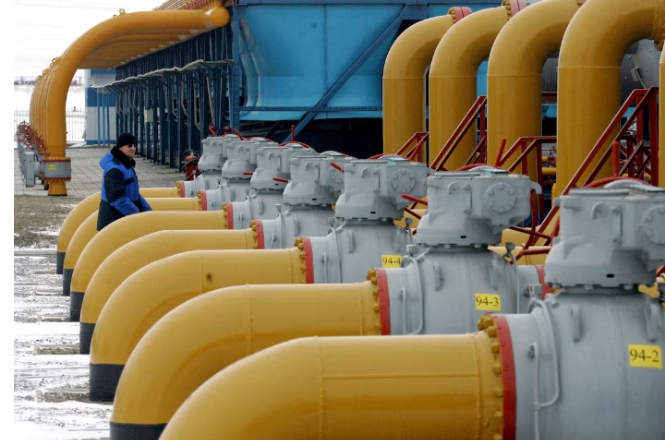By Adeyemi Adekunle
Russian gas exports through Ukraine came to a halt on Wednesday with the expiration of a long-standing transit agreement. The move marks the end of a decades-old route that had supplied Europe with Russian gas, forcing several nations to find alternative energy sources and accelerating the continent’s pivot away from reliance on Russian energy.
The decision to stop the flow was confirmed by Ukraine’s energy minister, German Galushchenko, said it as a significant blow to Russia’s economic standing. “We stopped the transit of Russian gas. This is a historic event.
Russia is losing its markets; it will suffer financial losses. Europe has already made the decision to abandon Russian gas,” Galushchenko said in a statement.
For Ukraine, the halt is more than just an energy issue—it’s a symbolic moment in its broader struggle against Russian aggression.
Russia’s state-owned energy giant Gazprom acknowledged the development, stating it no longer had the “technical and legal right” to send gas through Ukraine. The transit agreement’s expiration was long anticipated, but its impact will still be felt, particularly in parts of Europe that relied heavily on the route. While Russia retains the ability to export gas to Turkey and certain central European countries like Hungary and Serbia, the shutdown of the Ukrainian corridor underscores the shifting dynamics of global energy markets.
The fallout has already begun to ripple across the region. Moldova, a small country with deep energy ties to Russia, announced sharp cuts in energy consumption to cope with the loss of Russian gas. However, the broader European Union, having reduced its dependence on Russian energy since the 2022 invasion of Ukraine, downplayed the impact.
EU officials said the bloc’s gas infrastructure is now flexible enough to source supplies from non-Russian origins, ensuring central and eastern European nations can meet their energy needs.
The end of the transit agreement is part of a larger story that began with Russia’s invasion of Ukraine nearly three years ago.
That conflict spurred Europe to rethink its reliance on Russian gas, which had accounted for nearly 40% of the EU’s supply before the war. Sanctions, supply disruptions, and a concerted push for renewable energy have since reshaped the region’s energy landscape. Countries that once relied heavily on Russian pipelines have turned to liquefied natural gas (LNG) from the United States, Qatar, and other suppliers, as well as ramped up investments in renewable energy and infrastructure for alternative imports.
Still, the transition hasn’t been seamless. While wealthier EU nations have diversified their energy portfolios, smaller or less economically stable countries like Moldova face significant challenges. The government in Chisinau has urged citizens to conserve energy, reflecting the immediate strain of losing Russian supplies.
Meanwhile, nations like Hungary and Serbia, which continue to rely on Russian gas delivered through other routes, are left navigating the political and economic complexities of maintaining ties with Moscow.
For Russia, the halt is a stark reminder of its shrinking influence over Europe’s energy markets. Once the continent’s dominant supplier, Moscow has seen its role diminish drastically as European nations accelerate their shift to alternative sources. The financial losses for Russia are likely to be significant, adding to the economic strain of sanctions and the prolonged conflict in Ukraine. Yet, with remaining pipelines to Turkey and central Europe still operational, Russia retains a foothold in the region’s energy sector.
The European Union’s measured response reflects its efforts to prepare for such disruptions. Over the past few years, the bloc has made substantial investments in diversifying supply chains and reducing dependency on Russian gas.
EU officials have repeatedly stressed that the infrastructure is now robust enough to handle shifts in supply. However, the situation highlights the importance of continued investment in energy security and renewable alternatives.
For Ukraine, stopping Russian gas transit is a powerful statement of independence and resistance but not without cost. For a route that has been for decades with economy benefits attached it’s estimated that Ukraine through the halts of this decades-long deal will lose up to $1 billion a year in transit fees which has been in handy from Russia.
Amidst this end, Ukraine is expected to offset the impact, through quadruple gas transmission tariffs for consumers in it’s country from Wednesday, which could cost the country’s industry more than 1.6 billion hryvnias ($38.2 million) a year.
The route has long been a contentious point in relations between Kyiv and Moscow, with Russia using gas supplies as a political tool in the past. By cutting off the flow, Ukraine not only disrupts a key revenue stream for Russia but also reinforces its role as a nation determined to stand firm against its neighbor’s aggression.
As Europe adjusts to this new reality, the end of Russian gas transit through Ukraine is likely to accelerate existing trends. It’s a pivotal moment that looks not only at the country’s importance of energy independence, but coupled with the resilience of international partnerships, and the broader shift toward a post-Russian energy landscape.
While challenges remain, the continent’s ability to adapt and innovate will be key in navigating this critical juncture.




